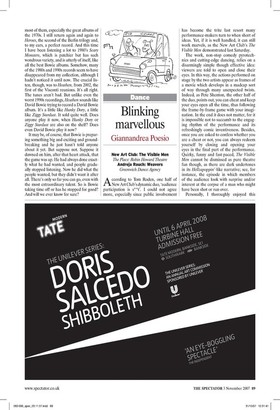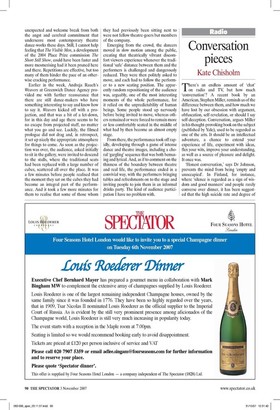Blinking marvellous
Giannandrea Poesio New Art Club: The Visible Men The Place: Robin Howard Theatre Andreja Rauch: Weavers Greenwich Dance Agency According to Tom Roden, one half of New Art Club's dynamic duo, 'audience participation is s**t'. I could not agree more, especially since public involvement has become the trite last resort many performance-makers turn to when short of ideas. Yet, if it is well handled, it can still work marvels, as the New Art Club's The Visible Men demonstrated last Saturday.
The work, non-stop comedy pyrotechnics and cutting-edge dancing, relies on a disarmingly simple though effective idea: viewers are told to open and close their eyes. In this way, the actions performed on stage by the two artists appear as frames of a movie which develops in a madcap sort of way through many unexpected twists. Indeed, as Pete Shenton, the other half of the duo, points out, you can cheat and keep your eyes open all the time, thus following the frame-by-frame game with your imagination. In the end it does not matter, for it is impossible not to succumb to the engaging rhythm of the performance and its refreshingly comic inventiveness. Besides, once you are asked to confess whether you are a cheat or not, you can always redeem yourself by closing and opening your eyes in the final part of the performance. Quirky, funny and fast-paced, The Visible Men cannot be dismissed as pure theatre fun though, as there are dark undertones in its HellzapoppinAike narrative; see, for instance, the episode in which members of the audience look with surprise and/or interest at the corpse of a man who might have been shot or run over.
Personally, I thoroughly enjoyed this unexpected and welcome break from both the angst and cerebral commitment that underscore most contemporary theatre dance-works these days. Still, I cannot help feeling that The Visible Men, a development of the 2004 Place Prize commission The Short Still Show, could have been faster and more mesmerising had it been pruned here and there. Repetitions are effective, but too many of them hinder the pace of an otherwise cracking performance.
Earlier in the week, Andrej a Rauch's Weavers at Greenwich Dance Agency provided me with further reassurance that there are still dance-makers who have something interesting to say and know how to say it. Weavers kicked off with a projection, and that was a bit of a let-down, for in this day and age there seems to be no escape from projected stuff, no matter what you go and see. Luckily, the filmed prologue did not drag and, in retrospect, it set up nicely the appropriate atmosphere for things to come. As soon as the projection was over, the audience, asked initially to sit in the gallery, were invited to descend to the stalls, where the traditional seats had been replaced with a large number of cubes, scattered all over the place. It was a few minutes before people realised that the moment they sat on the cubes they had become an integral part of the performance. And it took a few more minutes for them to realise that some of those whom they had previously been sitting next to were not fellow theatre-goers but members of the company.
Emerging from the crowd, the dancers moved in slow motion among the public, creating that theatrically vibrant discomfort viewers experience whenever the traditional 'safe' distance between them and the performers is challenged and dangerously reduced. They were then politely asked to move, and each had to follow the performer to a new seating position. The apparently random repositioning of the audience was, arguably, one of the most interesting moments of the whole performance, for it relied on the unpredictability of human beings. Some people stood up nervously before being invited to move, whereas others remained or were forced to remain more or less comfortably seated in the middle of what had by then become an almost empty stage.
From there, the performance took off rapidly, developing through a game of intense dance and theatre images, including a choral 'gargling' sequence that was both bemusing and lyrical. And, as if to comment on the thinness of the boundary between theatre and real life, the performance ended in a convivial way, with the performers bringing tables and refreshments on to the stage and inviting people to join them in an informal drinks party. The kind of audience participation I have no problem with.













































































 Previous page
Previous page